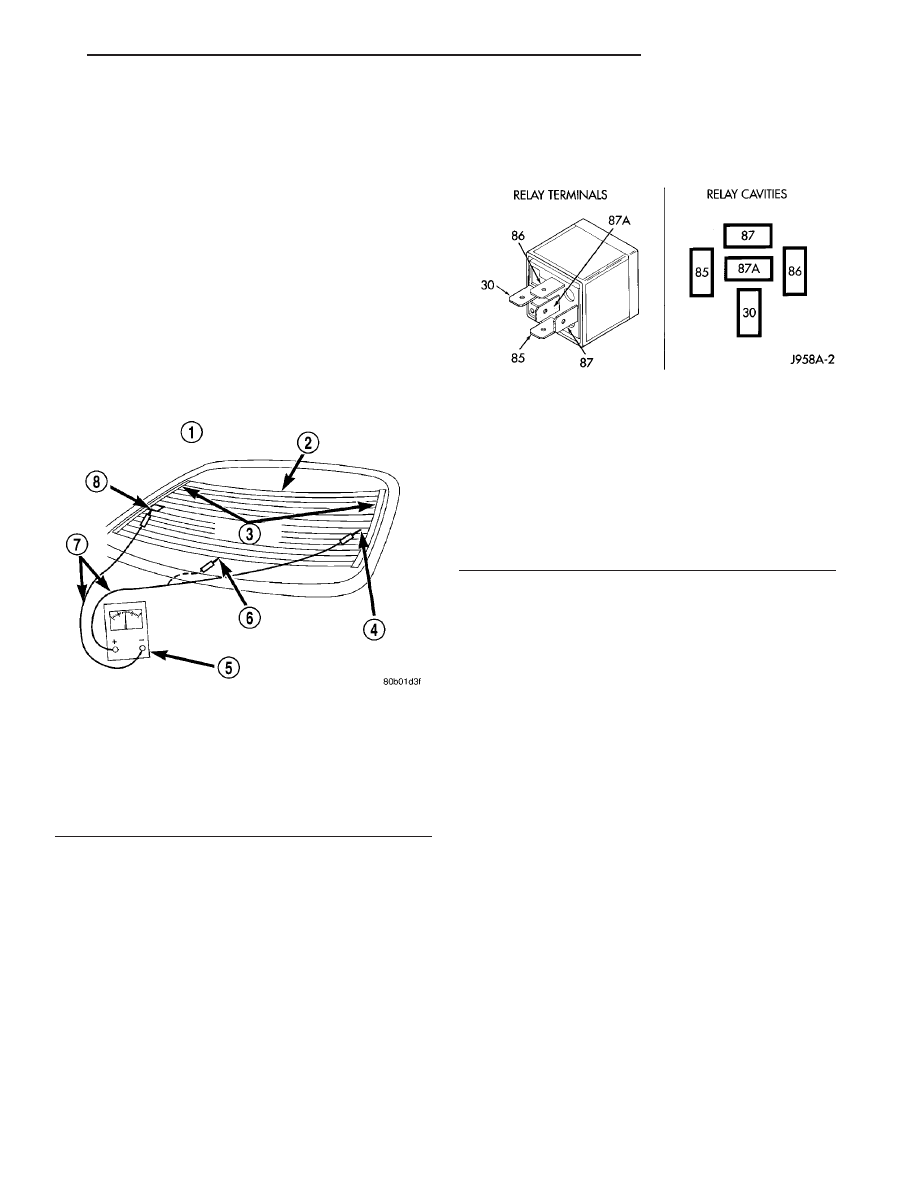Chrysler Sebring, Stratus sedan, Sebring Convertible. Manual - part 330

When the above steps have been completed and the
rear glass heating grid is still inoperative, one or
more of the following is faulty:
• Rear window defogger switch in the A/C-heater
control.
• Rear window defogger timing circuitry in the
body control module (BCM).
• Rear window defogger grid lines (all grid lines
would have to be broken, or the power feed or the
ground wire disconnected, for the entire heating grid
to be inoperative).
(3) If the EBL system operation has been verified
but the rear window defogger LED indicator does not
illuminate, check fuse 6 in the JB. If the fuse is OK,
replace the A/C-heater control (Refer to 24 - HEAT-
ING
&
AIR
CONDITIONING/CONTROLS/A/C
HEATER CONTROL - REMOVAL).
REAR WINDOW DEFOGGER
RELAY
DESCRIPTION
The rear window defogger (EBL) relay (Fig. 4) is a
International
Standards
Organization
(ISO)-type
relay. Relays conforming to the ISO specifications
have common physical dimensions, current capaci-
ties, terminal functions and patterns. The EBL relay
is a electromechanical device that switches battery
current through a fuse in the power distribution cen-
ter (PDC) to the rear window defogger grid and when
equipped, to the outside mirror heating grids. The
EBL relay is energized when the relay coil is pro-
vided a ground path by the control circuitry within
the body control module (BCM).
The EBL relay is located in the junction block (JB)
in the passenger compartment.
OPERATION
The ISO-standard rear window defogger (EBL)
relay is an electromechanical switch that uses a low
current input controlled by the body control module
(BCM) to control the high current output to the rear
window defogger grid lines The movable, common
feed relay contact is held against the fixed, normally
closed relay contact by spring pressure. When the
electromagnetic relay coil is energized, it draws the
movable common feed relay contact away from the
fixed, normally closed relay contact and, holds it
against the fixed, normally open relay contact. This
action allows high current to flow to the rear window
defogger grid lines.
When the relay coil is de-energized, spring pres-
sure returns the movable relay contact back against
the fixed, normally closed contact point. The resistor
or diode is connected in parallel with the relay coil,
and helps to dissipate voltage spikes and electromag-
netic interference that can be generated as the elec-
tromagnetic field of the relay coil collapses.
The EBL relay terminals are connected to the vehi-
cle electrical system through a receptacle in the
power distribution center (PDC). The inputs and out-
puts of the EBL relay include:
• The common feed terminal (13) receives fused
battery current at all times.
• The coil ground terminal (11) receives a ground
through the EBL relay control circuit only when the
BCM electronically pulls the circuit to ground.
Fig. 3 Grid Line Test
1 - VIEW FROM INSIDE VEHICLE
2 - REAR WINDOW DEFOGGER
3 - BUS BARS
4 - VOLTAGE FEED (A)
5 - VOLTMETER
6 - MID-POINT (C)
7 - PICK-UP LEADS
8 - GROUND (B)
Fig. 4 Rear Window Defogger (EBL) Relay
30
COMMON FEED
85
COIL GROUND
86
COIL BATTERY
87
NORMALLY OPEN
87A
NORMALLY CLOSED
JR
HEATED GLASS
8G - 3
HEATED GLASS (Continued)